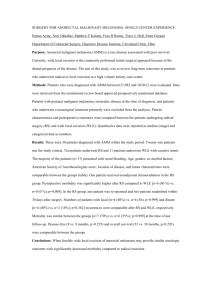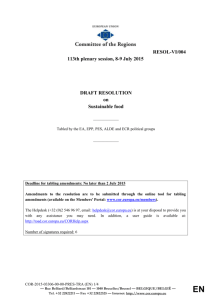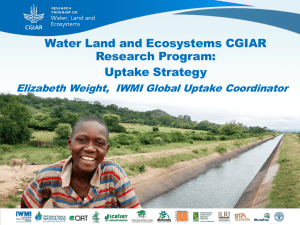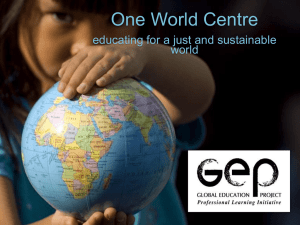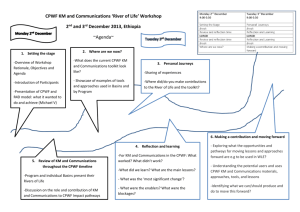WLE Focus Volta and Niger Region v 2 MVB+NDH+FDC
advertisement
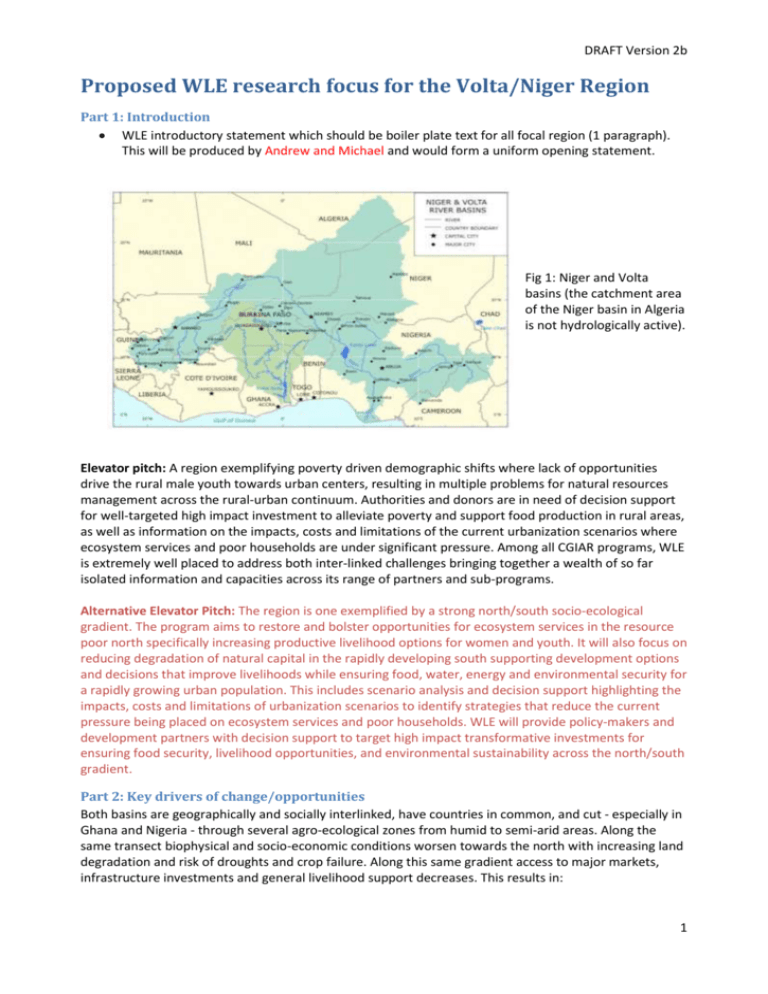
DRAFT Version 2b Proposed WLE research focus for the Volta/Niger Region Part 1: Introduction WLE introductory statement which should be boiler plate text for all focal region (1 paragraph). This will be produced by Andrew and Michael and would form a uniform opening statement. Fig 1: Niger and Volta basins (the catchment area of the Niger basin in Algeria is not hydrologically active). Elevator pitch: A region exemplifying poverty driven demographic shifts where lack of opportunities drive the rural male youth towards urban centers, resulting in multiple problems for natural resources management across the rural-urban continuum. Authorities and donors are in need of decision support for well-targeted high impact investment to alleviate poverty and support food production in rural areas, as well as information on the impacts, costs and limitations of the current urbanization scenarios where ecosystem services and poor households are under significant pressure. Among all CGIAR programs, WLE is extremely well placed to address both inter-linked challenges bringing together a wealth of so far isolated information and capacities across its range of partners and sub-programs. Alternative Elevator Pitch: The region is one exemplified by a strong north/south socio-ecological gradient. The program aims to restore and bolster opportunities for ecosystem services in the resource poor north specifically increasing productive livelihood options for women and youth. It will also focus on reducing degradation of natural capital in the rapidly developing south supporting development options and decisions that improve livelihoods while ensuring food, water, energy and environmental security for a rapidly growing urban population. This includes scenario analysis and decision support highlighting the impacts, costs and limitations of urbanization scenarios to identify strategies that reduce the current pressure being placed on ecosystem services and poor households. WLE will provide policy-makers and development partners with decision support to target high impact transformative investments for ensuring food security, livelihood opportunities, and environmental sustainability across the north/south gradient. Part 2: Key drivers of change/opportunities Both basins are geographically and socially interlinked, have countries in common, and cut - especially in Ghana and Nigeria - through several agro-ecological zones from humid to semi-arid areas. Along the same transect biophysical and socio-economic conditions worsen towards the north with increasing land degradation and risk of droughts and crop failure. Along this same gradient access to major markets, infrastructure investments and general livelihood support decreases. This results in: 1 DRAFT Version 2b a) a strong poverty gradient from south to north, which is accompanied by increasing tension between crop and livestock based farming systems, different ethnic groups and religions. b) a demographic shift from north to south with strong rural-urban migration patterns attracting the younger male generation of rural farmers and resulting in one of the strongest urbanization rates of the continent. With strong cross-border migration within the West African subregion, e.g. more than 40% of the Greater Accra Region population are immigrants from other regions. The result of these two interlinked phenomena are (i) very poor farming communities along the resource poor regions of the upper part of the Niger and Volta basins, (ii) some of Africa’s largest urban agglomerations, especially notable within Nigeria and along the Abidjan-Lagos corridor, and interrelated (iii) a new distribution of poverty with projections that the majority of the subregion’s poor will soon live in urban and peri-urban areas (UN-Habitat, 2010). This demographic shift has a strong gender dimension as mostly the young male population is leaving rural areas, while women’s workloads and responsibilities have increased. In addition, women’s already limited access to assets such as land, water and livestock perilously restricts their ability to ensure the wellbeing and survival of their families and themselves. In urban and peri-urban areas, on the other hand, population growth has since long outpaced planning especially in terms of drinking water, waste management and sanitation (ISSER, 2013). Moreover, to serve the growing urban markets, farming systems in urban proximity are undergoing rapid intensification, with widespread use of wastewater and agro-chemicals, and little consideration for human and environmental health. From a WLE perspective, we see in this context major NRM challenges which we summarize in three overarching modules (possible WLE Volta-Niger Research areas/calls) with the following R4D led questions of relevance, also beyond the region: 1. Can we better guide and target sustainable agricultural investments in the rural north in such a way that farming remains attractive, so that farmers are recognized for the multiple ecosystem services they provide, and so that farming fulfills its role in sustaining livelihoods, mitigating poverty and feeding the region? 2. Can we guide decision makers to value and better manage the restoration of degraded lands or ecosystem services in general, in the north, and reduce the pressure on ecosystem services in the growing peri-urban landscapes of the south and south-east? 3. What policies and intervention decision would strengthen farming households affected by male outmigration, including dealing with the high rates of illiteracy found in these areas? Figure 2: High degree of land degradation in both, Sahel and urbanized areas (brown colour), and female illiteracy (filled blue spots) especially in the Islamic Sahel. Out of ten countries with lowest literacy rates in the world, seven are in West Africa. 2 DRAFT Version 2b From the global perspective, the region is an example for demographic shifts where decision makers lack the means to support people in rural areas while equally failing to support a sustainable urban development to absorb those migrating, which results more in a geographical redistribution of poverty than poverty alleviation. Ecosystems services, biodiversity and environmental health are under particular pressure through urban growth. Our value proposition is that this pressing rural-urban dimension in NRM research is currently not being addressed by any CRP or other large scale R4D effort. This includes novel work not only considering the impact of urban expansion on ecosystems under different demographic development scenarios, but more importantly decision support for (i) better investments in rural areas, with a focus on gender disparities, and (ii) resource use planning and ecosystem service management in urban proximity. The ultimate goal is to support for different demographic development scenarios the ability of low income communities to adapt to environmental and economic variability, demographic shifts, and long term changes, which is one of the CGIAR IDOs. Part 3: Building on previous initiatives WLE builds in the strong history of work in the region by CPWF and various WLE partners, including FAO. The constellation of CGIAR centers and partners working jointly in the region continues to provide a novel opportunity to address the outlined challenge areas using multidisciplinary and systems based approaches that focus on the nexus between people, nature, and resilience: 1. Guiding investments into farming: Just one decade ago, most programs and projects worked at local level, testing ‘best practices’ in sustainable land and water management on station or farm. Current developments allow for up-scaling of results using geographical information systems where innovation requirements demand both bio-physical and socio-economic information. This approach allows us to target and prioritize innovations to particular socio-economic groups and geographical areas to reduce the failure rate of conventional technology transfer. WLE can integrate and build here on several, so far separate databases on soil, biodiversity, and water and soil conservation interventions and technologies: a) the BMGF funded and IWMI-led AgWaterSolutions project with its GIS based and FAO-led country investment assessments for 3-6 interventions in Burkina Faso and Ghana based on hydrological, livelihood and market access data. b) The CPWF/SEI developed GIS-based online decision support tool (TAGMI) for the same two countries, which is assessing the likelihood of success for so far three interventions using community based social and bio-physical factors. c) the IWMI database on ‘scaling-up potential’ of existing agricultural water management (AWM) and land and water conservation solutions. d) the GIS database of ICRAF/CIAT on land health and soil fertility in Africa, e) the data of the Sahel based ICRISAT GIS unit, like on operationalizing bio-economic decision support tools to improve the livelihoods of Sahelian smallholder in Niger f) the IFDC value chain management tool with GIS interface, funded by AGRA aiming at market information e.g. through mobile phone-based mechanisms in West Africa. g) the Bioversity SDC funded program and databases on improved seed systems to mitigate the impacts of pests and diseases in Burking Faso. An integration of these so far little related efforts in both basins could be a low-hanging fruit which could be commissioned to a consortium of WLE partners with the task to a) align the databases, b) create an open-access GIS interface, and c) increase the targeting and number of interventions covering crop and livestock farming in e.g. four selected countries. Co-funding opportunities might come for example from USAID’s JPC Strategy. To move such a decision making tool into actual use and decision making, i.e. from output to outcome, the tool has to go beyond ‘being online’. This requires partnerships for innovative communication pathways and impact projections investors are looking for (see below). 3 DRAFT Version 2b 2. Guiding the management of ESS under demographic pressure: This component can extrapolate studies of IWMI in Ghana on modeling different urban demand scenarios on water allocations in the basin context, need for water storage, and related costs, and by CPWF/IWMI on the safe but productive reuse of urban waste resources, in particular wastewater. The experience of Bioversity and IFPRI in mapping, targeting and valuing ecosystem services will be a crucial asset, next to the efforts of various partners in providing evidence-based solutions to feed a growing population, while promoting long-term conservation of vital biodiversity and other ESS. A particular hydrological research challenge will be the uncontrolled private groundwater abstraction in urban areas. A key element to move from research to outcomes in the rural-urban interface would be multistakeholder platforms. WLE has significant experience in this field in the subregion, also in the peri-urban interface, e.g. through IWMI’s RUAF and SWITCH projects. Research can feed information into these platforms for informed decision making on required investments or institutional reform to improve adequacy, reliability, efficiency and equity in land and water resources management across the interface. 3. Strengthen farming households affected by male outmigration: WLE can look at a patchwork of gender initiatives across its partner centers which offer several entry points for addressing this challenge, like IWMI’s RUAF project which supported female led households to link to the value chain in peri-urban areas (Amarasinghe et al., 2013), or the analysis of gender dimensions of the adoption of small-scale private irrigation technologies (Van Koppen et al., 2012). Women are often overlooked during the development and dissemination of new technologies or practices. Thus any decision support should recognize that the target group might be a largely female household. As agriculture is key to women’s economic empowerment, women friendly innovations and process of decision making, will be part of the supported interventions. Part 4 &7: Key areas of interventions and related research questions The expert group suggests to focus the efforts on four countries (Burkina Faso (part of both basins), Niger, Ghana and Nigeria), which cover a large part of the Sahel as well as of the urbanizing South ultimately with the aim of a regional analysis. Significant parts of the research would be modeling which will allow us to produce outputs clearly beyond any local scale. For example, regional investment plans and scenarios for different rural-urban water demands at catchment scale and the impact of socioecological context on sustaining environmental, rural and urban water needs. The inclusion of Ghana and Burkina will allow a head start and is strategic to build on and expand the work done by the CPWF. Fig 3: Three intervention areas suggested for the Volta-Niger basins 1. Guiding investments into farming 3. Strengthening farming households affected by male outmigration 2. Guiding the management of ESS under demographic pressure Key research questions per area are: 1. Guiding investments into farming How best to target recommended interventions and innovations (technical, social, economic, institutional) to improve their adoption and impact? 4 DRAFT Version 2b What are the beneficiary numbers and return on investment for each intervention? What are the economics of scale in investing in the highest ranking interventions across the basins, and what could be the negative tradeoffs? 2. Guiding the management of ecosystem services under demographic pressure Which options exist, including ecosystem service based ones, for propoor rural-urban water allocations and food supply in the basin context? How best to minimize the negative urban footprint on ecosystems services and livelihoods and what are the costs of action versus nonaction? How much storage do urban households need and how best to institutionalize rainwater harvesting and safe wastewater reuse? How long will the informal groundwater access still support urban water demand and how to manage it sustainably? 3. Strengthening farming households affected by male outmigration How best to support the new generation of female and male farmers with opportunities and (e.g. entrepreneurial) skills and value chain access to stay in rural farming? How best to support woman in accessing information on value chain opportunities? How far does gender specific analysis and intervention choices change the results analyzed under (1)? Part 5: Outcomes/Impact pathways/target groups The expected research outputs are easily accessible and understandable information for authorities and donors to make better informed decisions with a clear understanding of the likely returns on investment. The related outcomes are a) better targeted investments in interventions and innovations supporting (rural) farming in both basins, b) better understanding of the consequences and costs of uncontrolled urbanization in rural-urban planning, and c) investments in gender-specific needs and opportunities, both in rural and rapidly urbanizing hotspots. This can be quantified by the number of ministries, policy makers and donors citing or using the provided information. The overall impact pathway is based on tailoring information to the needs and expectations of the target groups and the identification of the most appropriate agents/platforms to reach them. In detail: To reach scale, the eventually suggested investment options (area 1) target first of all decision makers at national level as well as donors supporting the region. Their decisions on smart investments will then reach beneficiaries at community and household level. This implies two responsibilities: The DSS has to be accessible and tailored to the expectations of the investors (e.g. bang for buck information), and be pro-poor and gender sensitive. The planned online based tool with a geographic resolution at district level will be a key step, but might still require innovative thinking to actually reach the target group. As research area 2 targets the institutionally grey rural-urban corridor, changes can only be achieved through multi-stakeholder platforms bridging between administrative silos and sectors. Feeding research results, such as development scenarios and related costs into these platforms has been shown to have a high probability of change. For area 3, the approach of targeting both gender will have the highest probability of success. However, the right information pathways and change agents to reach out and achieve impact beyond those identified for area 1 and 2 have still to be identified. This will be a key part of the research. 5 DRAFT Version 2b The proposed action will support all 5 IDOs adopted by WLE with higher shares in the following three, and in particular in the last: Increased and more equitable income from agricultural and natural resources management and ecosystem services in rural and peri-urban areas Women and marginalized groups have decision making power over and increased benefits derived from agriculture and natural resources Increased ability of low income communities to adapt to environmental and economic variability, demographic shifts, shocks and long term changes Part 6: R4D areas of work (could provide examples of different work packages) To suggested research is directly feeding into investment programs and stakeholder platforms, and will link from the start to these target groups to meet their expectations. Part 8: Partnership strategies and key partners For the different research tasks we will have several key research partners within WLE, incl. FAO, and opportunities for all 5 SRPs and two working groups to join forces. External research partners will be e.g. SEI, IFDC and WASCAL, as well as local universities, also for gender research. Uptake pathways have been described under Part 5 above. Uptake partners will be peri-urban stakeholder platforms (Ghana and Nigeria), and national decision makers and regional investors, such as AfDB, IFAD, USAID, CIDA and ECOWAS. Several of these donors have strong gender programs which should appreciate the here sketched area. Annex: Who was involved - - The presented CN is based on discussions at the Volta-Niger basin multi-stakeholder consultation workshop organized by WLE in Accra and an extensive review of literature from both basins and the region as well as expert interviews. The first draft was discussed at a WLE Science meeting in Amman with representatives from WLE partners and SRPs and also considered first feedback from regional representatives, and based on this input revised and transferred in the current format. The current version has been compiled by Fabrice DeClerck, Nicoline de Haan, Martin van Brakel and Pay Drechsel. List of high-level individuals or organizations consulted. (in January) 6
